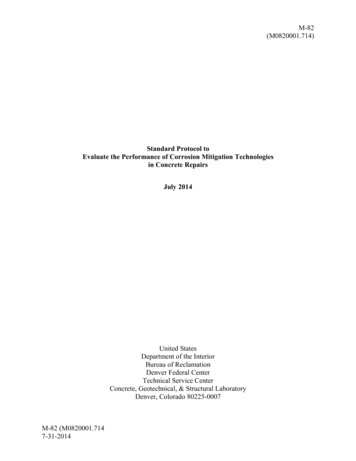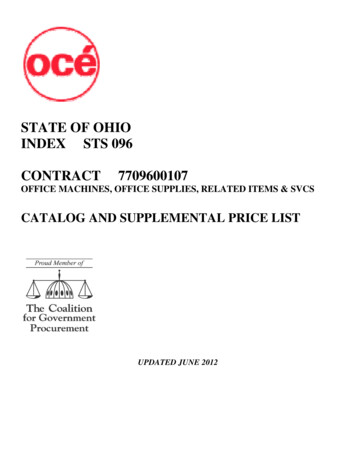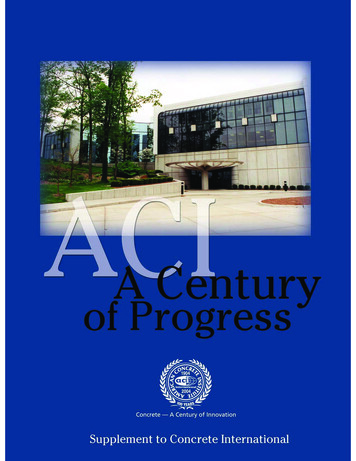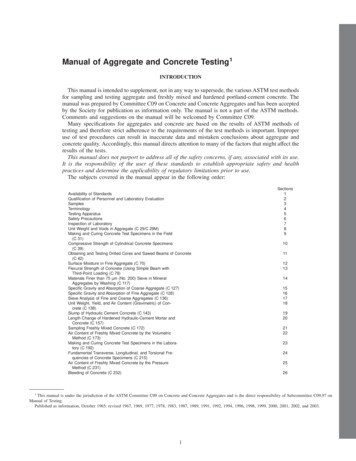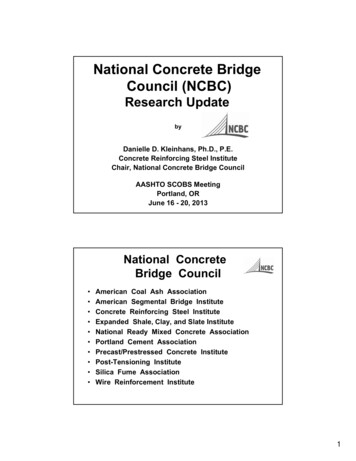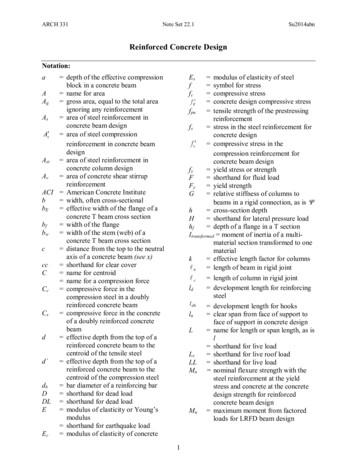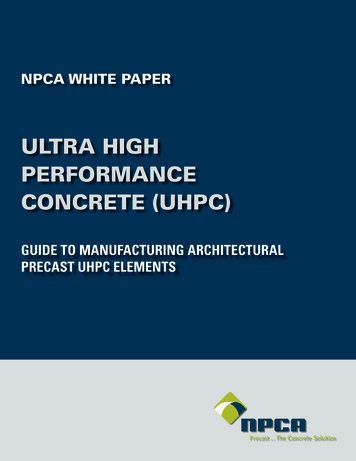
Transcription
NPCA WHITE PAPERULTRA HIGHPERFORMANCECONCRETE (UHPC)GUIDE TO MANUFACTURING ARCHITECTURALPRECAST UHPC ELEMENTS
GUIDE TO MANUFACTURING ARCHITECTURALPRECAST UHPC ELEMENTSTABLE OF CONTENTSINTRODUCTION. 3SECTION 1: PURPOSE. 3SECTION 2: WHAT IS ARCHITECTURAL UHPC?. 3SECTION 3: RAW MATERIALS. 4Placing. 8Finishing.8Curing and Demolding.8Thermal Treatment.8Plant Requirements.9Dry Materials. 4Plastic Properties. 9Fiber Reinforcement. 4Hardened Properties. 9Water. 4Plant Requirements. 10Chemicals. 4Accelerators. 4SECTION 6: PRECAST UHPC APPLICATION. 10Architectural UHPC applications. 10Color pigments. 4Curves. 10Storage of Raw Materials. 4Texture. 11SECTION 4: MANUFACTURING ARCHITECTURAL UHPCPRECAST CONCRETE ELEMENTS. 5Perforated and Lattice Panel Systems. 11Artisan. 12Batching. 5Interior Decor. 12Forming. 6Urban Furnishings. 14Placing. 6Mega Architectural Projects. 14Curing. 7Surface Treatment. 7MuCEM. 15Mock-ups. 8SECTION 5: QUALITY CONTROL. 8Stade Jean Bouin. 15SECTION 7.: COMMERCIALIZATION AND THE ECONOMICSOF UHPC. 16Batching. 8This publication is designed to provide accurate and authoritative information with regard to the subject matter covered; however, theNational Precast Concrete Association acts as a mediator without approving, disapproving or guaranteeing the validity or accuracy ofany data, claim or opinion appearing herein. Information is provided and disseminated with the understanding that the National PrecastConcrete Association is not engaged in rendering engineering, legal or any other professional services. If engineering, legal or otherprofessional assistance is required, the services of a competent professional should be obtained. The National Precast Concrete Association does not assume and hereby disclaims liability to any person for any loss or damage caused by errors or omissions in the materialcontained herein, regardless of whether such errors result from negligence, accident or any other cause whatsoever.COPYRIGHT 2013 by NATIONAL PRECAST CONCRETE ASSOCIATION 1320 CITY CENTER DR., SUITE 200, CARMEL, IN 46032National Precast Concrete Association precast.org2
INTRODUCTIONAs a material on the leading edge of concrete innovation,ultra high performance concrete (UHPC) provides a newtechnology to expand a precaster’s business with newproducts and solutions. The material’s combination of superiorproperties facilitates the ability to design thin, complex shapes,curvatures and highly customized textures – applications whichare difficult or impossible to achieve with traditional reinforcedconcrete elements.UHPC is a range of formulations which may be used for manydifferent architectural and structural applications. Reinforced withhigh-carbon metallic fibers, structural UHPC products can achievecompressive strengths up to 29,000 psi (200 MPa) and flexuralstrengths up to 2,900 psi (20 MPa). For architectural UHPCapplications, Polyvinyl Alcohol (PVA) fibers are typically used.Architectural UHPC can achieve compressive strengths up to17,000 psi (117 MPa) and flexural strengths up to 2,900 psi (20MPa). Due to the material’s superior compressive and flexuralproperties, the need for passive reinforcing can be eliminated orgreatly reduced (depending on the application). It is also highlymoldable and replicates form materials with extreme precision.Currently, the use of steel fibers in strictly architectural UHPCapplications is very limited, however some projects which fall intoboth architectural and structural categories, such as the MuCEMand Jean Bouin Stadium, have begun using steel fibers.The advantages of UHPC are numerous and typically includereduced global costs such as formwork, labor, maintenanceand speed of construction. For more than a decade, UHPC hasbeen used by innovative precasters worldwide in ways thatcomplement their existing businesses by expanding their productranges to include new solutions for structural and/or architecturalmarkets. Applications include bridge beams and decks, solid andperforated wall panels/facades, urban furniture, louvers, stairs,large-format floor tiles, pipes and marine structures.SECTION 1: PURPOSEThe purpose of this report is to provide a guide for themanufacture of architectural precast UHPC elements andeducate precasters on the potential opportunities thatexist through production of innovative products and solutionsthat complement their existing businesses. The followingreport describes the general handling and quality controlprocedures including the storage, forming, batching and curingof architectural UHPC. In addition, several applications utilizingarchitectural precast UHPC elements are discussed.National Precast Concrete Association precast.orgThis open lattice facade comprised of UHPC at the StadeJean-Bouin in Paris allows sunlight to filter through.(Photo courtesy of Lisa Ricciotti)SECTION 2: WHAT IS ARCHITECTURALUHPC?Architectural precast UHPC products reach a minimumcompressive strength of 17,000 psi (117 MPa) after 28days. They are blended with fibers in order to achieveductile behavior under tension, which may eliminate the needfor passive (non-prestressed) reinforcement. Appropriatebatching, casting, finishing and curing procedures are of theutmost importance in order to ensure the highest level ofquality, appearance and performance.The main principle of this technology is based on systematicelimination of inherent weaknesses associated withconventional concrete. The ductile behavior of this material isa first for concrete, with the capacity to deform and supportflexural and tensile loads, even after initial cracking. Thesesuperior performance characteristics are the result of improvedmicrostructural properties of the mineral matrix and control ofthe bond between the matrix and the fiber.The optimization of granulars, fibers and admixtures providea very low porosity in a cement-based mineral granulometricmatrix. The premix components consist of granular materialwith a diameter less than 1 mm, and a highly reduced watercement ratio (less than 0.25, depending on the type of UHPC3
formulation). Elimination of coarse aggregates, along with thegranular gradation and fiber aspect ratio, facilitates a high fibercontent and isotropic dispersion.Due to UHPC’s plastic and hardened properties, plus theelimination of rebar, precasters can achieve complex shapesthat are extremely durable and cost effective, and requirelittle maintenance. The material replicates textures, form andshape with high precision and can be produced in a range oflong-lasting colors. It works well for new, innovative concreteapplications and supports new trends in architecture: purity ofline, delicacy, enhancement of texture and mineral bias.With UHPC, precasters can offer new, innovative buildingenvelope solutions for creative architects; for example:structural, decorative perforated facades in mesh or latticestyle designs; ultra thin, lightweight panels with large surfaceareas and perforation rates that exceed 50%; and full facadeswith complex shapes, curvatures and textures.UHPC has also been used in a variety of urban furnishings.Because of its strength, impact resistance, durability and lowmaintenance requirements, it is an excellent alternative totraditional materials. A range of elements, such as sculptures,benches, bollards and street furnishings, have been addedto the product offerings of traditional precast manufacturers.Also, interior designers and precasters may create new,contemporary, lightweight, colored and textured productssuch as chairs, stairs and tiles for floors and walls.SECTION 3: RAW MATERIALSDry MaterialsThe dry materials in UHPC are cement, silica fume, groundquartz and silica sand. These materials conform to the MillCertificate specifications; a copy of each is kept on file.Fiber ReinforcementArchitectural UHPC precast products are fiber reinforcedwith fibers having a minimum tensile strength of 140 ksi anda diameter of up to 300 microns. Steel fibers may also bespecified in architectural UHPC applications, particularly whenvery thin sections are desired and the UHPC members areprojected to experience excessive wind pressures and tensileloads. Steel fibers used in architectural UHPC have a minimumtensile strength of 310 ksi and diameter of up to 200 microns.The fibers conform to the Mill Certificate specifications. Acopy of each Mill Certificate is kept on file.National Precast Concrete Association precast.orgWaterWater should be potable (drinkable), but if not potable it mustbe free of contaminations such as oils, acids, salts, chlorides orother compounds that may be harmful to concrete.ChemicalsAdmixtures for concrete are used to enhance and/or obtaincertain properties of fresh and hardened UHPC. High-rangewater reducers are essential to UHPC for providing theplasticizing effects, allowing the concrete to flow to selfconsolidation. Air-entraining admixtures are not used in UHPC.AcceleratorsThere are two types of accelerators that alter the early strengthcharacteristics of concrete in distinct ways. Set acceleratorsshorten the set time, whereas strength accelerators speedup early strength gain but do little to alter the initial setcharacteristics. The dosage rate varies by supplier. Consult thesupplier for product details and mix time prior to incorporatingan accelerator. Calcium chloride accelerators are notrecommended, as the additional chlorides promote degradationof reinforcement and may promote drying shrinkage. The 28day strength of concrete with the incorporation of acceleratingadmixtures may be slightly lower than mixes without them.Color PigmentsSolid or liquid pigments can be utilized for architectural UHPC.Solid Pigment: When using a solid pigment, the flowproperties start to change once the volume surpasses 1%of total dry materials. In order to maintain similar flow, waterwill have to be added to compensate for the additional drymaterial. The only way to know the exact impact of this changeon the UHPC properties is through testing.Liquid Pigment: When using liquid pigment, one must beaware of the water being added to the concrete mix. If theliquid pigment dose surpasses the maximum of 3% massof dry materials, the user could cause negative effects onthe UHPC matrix, which must be validated using appropriatelaboratory testing methods.Storage of Raw MaterialsA dry, separate storage area for UHPC raw materials must beprovided, as raw materials should not be exposed to moisture.Chemical admixtures must not be exposed to freezingtemperatures.4
Figure 1 (top left) – High shear mixer; Figure 2 (left) – Small(14-50 bags mixer); Figure 3 (above) – UHPC batchingfacility. (Photos courtesy of Lafarge)SECTION 4: MANUFACTURING ARCHITECTURAL UHPC PRECAST ELEMENTSThe manufacture of precast UHPC elements presentsthe industry with new challenges and opportunities.Recognizing that production methods must bereassessed for UHPC production, it is a fundamental changeto conventional manufacturing processes. For instance,precasters are required to review their current batchingmethods, casting techniques, molding expertise and handlingtechniques.BatchingTo date, many different UHPC product formulations havebeen successfully batched in various mixers, ranging froma small two-bag mixer to a fully automated batching plant.The mixing efficiency and mixing performance depends on:the type and speed of the mixer; requested mixing time bythe precaster; and the required UHPC volume for precastproduction. When setting up the batch plant for UHPC at aNational Precast Concrete Association precast.orgprecast facility, the introduction of raw materials into themixer must be considered. The key to producing high-qualityUHPC products is very precise proportion control of rawmaterials, temperature control and optimization of the mixer’sperformance requirements.For the most efficient and consistent mixing of UHPC,high shear mixers (Figure 1) have been used successfully,especially counter-current pan mixers, which can provideaccelerated mixing times. These high shear mixers dispersewater and admixtures onto the cement particles withoutheating the mix through kinetic energy generated by themixing process. Others, such as mortar, horizontal shaftor pan mixers (Figure 2) have also been used, but they aregenerally slower. The precaster should therefore considerthe tradeoffs of mixing time, batch volume and materialplacement. Prior to dedicating a mixer for UHPC production, itis recommended to calibrate the mixer by measuring mixingtime and flow characteristics of UHPC and comparing thecompressive strength to reference strength. For projectsrequiring larger volumes, mixing procedures have been5
Figure 4 – Placing UHPC behind the leading edge.Figure 5 – Injection casting.perfected to allow batching of UHPC in ready mix concretetrucks.new range of products with almost any surface texture on allsides of the element.When setting up the batching facility (Figure 3) for UHPCmanufacturing, precasters must consider how each of thematerials is weighed and proportioned prior to mixing.Accurate proportioning is essential in successful batchingof UHPC (see Table 1). The dry material is added first tothe mixer, then the water and liquid superplasticizers areintroduced. Once the batch is fluid, the weighed fibers areadded to the mixer. When turning the UHPC formulation fromdry to liquid stage, significant energy is required by the mixer.Therefore, batch sizes are often reduced, from 40% to 75%of the recommended size by the mixer manufacturer. Prior toplacing of UHPC, the mixer may be slowed down in order toallow entrapped air to escape due to the high-speed mixing.Entrapped air may lead to a weaker matrix and poor surfacefinish of the precast element.For accurate mold design, any potential deflections and initialUHPC shrinkage must be considered. Specific molding detailsare all critical success factors to consider when designing,building and using formworks. Some of these specific detailsinclude:(Photo courtesy of Lafarge)Self-leveling or dry-casting formulations are possible,depending on the casting technique and performancerequirements.(Photo courtesy of Lafarge) Release agents Type of molding materials Methods of release during initial shrinkage Orientation Mold supportSince UHPC replicates surfaces with great precision, theselection of the mold material is based on the expectedsurface outcome. The following molding materials havebeen used successfully in the manufacture of various UHPCprecast elements: steel, silicone, lexan, polyurethane, Teflon,glass and wood (with epoxy painted surfaces).PlacingFormingSuccessful execution of a precast UHPC project depends onthe design of the molds and the procedures developed touse them. Traditional hand screeding and finishing of UHPCis not normally used due to its high flow and fiber contentof the plastic matrix. Self-leveling UHPC formulations haveno internal shear in the plastic state and behave similar toself-consolidating concrete. This creates challenges whendeveloping formworks that are completely enclosed with tighttolerances, as well as opportunities for the precaster to offer aNational Precast Concrete Association precast.orgThe casting sequence of architectural UHPC precastelements should be planned in order to achieve anappropriate preferential fiber orientation. Molds are filledslowly to prevent entrapped air. No internal vibration ispermitted. Limited external vibration can be used to aid in airremoval. Do not allow excessive external vibration, as PVAfibers may float to the surface. Filling of the molds shouldbe completed in a continuous casting process by followingbehind the leading edge of the UHPC.When placing the self-leveling UHPC material into formworks,6
Figure 6 – The Shawnessy LRT Station, Calgary, Alberta.Figure 7 – Displacement casting.it is important to take advantage of its fluid characteristics.When discharged from a concrete bucket onto flat-surfacemolds, UHPC will create a mass of material that will spreaditself throughout the form. By moving the discharge pointat a rate such that it always stays behind the “leadingedge” of the flow (Figure 4), the mold can be filled in onecontinuous motion. This is important, because if UHPC flowsmeet each other, there will be minimal fibers bridging thejunction, resulting in a weak plane. Due to the material’s fluidcharacteristics and fiber dispersion, it cannot be finished thesame way as traditional concrete (such as raking, troweling orbrooming). After placement, any exposed surfaces must becovered in order to prevent dehydration.exact positioning of the top form and considerable forceof displacement are required. For a high-quality surfaceappearance, molds must be filled slowly to prevent entrappedair; also, control of the fluid’s rheology minimizes segregationof the fibers.(Photo courtesy of Lafarge)UHPC’s high flow properties also permit special castingtechniques such as injection (Figure 5) and displacementmethods to create sophisticated forms and shapes thatcannot be achieved with conventional casting techniques. Forinstance, an innovative injection technique was successfullyused to produce a complex canopy roof system for theShawnessy LRT Station (Figure 6) in Calgary, Alberta. For thisproject, the UHPC material was forced into a complex steelmold through a piping system by applying air pressure abovethe plastic material.Displacement casting (Figure 7) is another method that offersnew opportunities for precasters. This process is completedby depositing the precise volume of material needed, andthen introducing the top portion of the mold. This will displacethe plastic material into the shape of the casting. If the entrypoints of the secondary form are controlled, it is possibleto move the plastic UHPC in directions that will influencefiber orientation and facilitate the release of entrapped air.For this casting method, alignment guides to control theNational Precast Concrete Association precast.org(Photo courtesy of Lafarge)CuringArchitectural precast UHPC elements are typically removedfrom the mold after final set has been reached (11,000 psi).If the elements have structural requirements, they can bethermally treated after setting and demolding. This processrequires the UHPC precast element to be exposed to 140 F at95% relative humidity for 72 hours. This allows the hardenedarchitectural UHPC element to reach its ultimate strengthand durability characteristics by hydrating all of the free waterwithin the matrix. Thermal treatment also provides improveddimensional stability of the product.Surface TreatmentDifferent sealers can be used with architectural UHPCproducts. The type of sealer depends on the application. Forinstance, vertical elements do not typically require muchabrasion resistance but could be exposed to substantial heat,UV light and staining. Horizontal precast applications couldbe exposed to the same conditions as vertical applicationsas well as abrasion. Topical sealers generally repel stainingbut perform poorly with respect to abrasion. Penetratingsealers tend to bond well into the micro surface of UHPC andperform well in abrasive conditions but do not perform wellwith staining. It is therefore recommended that the precastertest small samples to determine whether the desired result7
Table 1Batch Size 5L(0.2 ft3) 30 L(1.1 ft3)Scale Accuracy0.1 g1.0 gcan be achieved.Mock-upsUHPC architectural projects typically require production ofprecast samples and/or mock-ups for evaluation. The samplesmust represent the desired color, texture and special shapes(if applicable) of the finished product. To achieve successfulcompletion of any UHPC project, it is recommended that thisis a Best Practice procedure.SECTION 5: QUALITY CONTROL 150 L(5.3 ft3) 1 m3(1.3 yd3) 1 m3(1.3 yd3)10 g(1/3 oz)100 g(0.2 lbs)1000 g(2.2 lbs)PlacingThe casting sequence of architectural precast UHPC elementsshould be planned in order to achieve appropriate preferentialfiber orientation. Molds are filled slowly to prevent entrappedair. No internal vibration is permitted. Limited external vibrationcan be used to aid in air removal. Do not allow excessiveexternal vibration, as it causes PVA fibers to float to thesurface. Filling of the molds requires one continuous casting byfollowing behind the leading edge of UHPC.FinishingHand tools may be used to control excess material near theedges of the form or to push the material into areas where thehe most important quality control measures forflow is not effective. Avoid tearing UHPC with hand tools. Avoidarchitectural precast elements are performed duringusing rakes or any tools that may disrupt the fiber orientationproduction. The quality control measures during theplastic and hardened states of UHPC must be followed for the of UHPC. Exposed surfaces must be covered or treated with acuring compound to prevent dehydration of UHPC.successful production of architectural UHPC.TBatchingCuring and DemoldingThe key to producing high-quality UHPC products is veryprecise proportion control of raw materials, temperaturecontrol and optimization of the mixer’s performancerequirements.Curing temperatures and time should be recorded until aminimum required demolding strength 75 MPa (11,000 psi) ora minimum percentage of degree of hydration is achieved. It isrecommended that curing temperatures of the UHPC productremain between 40 ºF and 105 ºF. Depending on the rawmaterial selections and curing temperatures, UHPC elementscan be demolded between 24 and 48 hours. Appropriatelifting equipment and systems are required to ensure the safemovement of architectural UHPC elements without cracking.For accurate proportioning of the raw materials, the weighscales have the following accuracies (Table 1). Note that allliquid and dry raw materials must be weighed for successfulbatching of UHPC.The temperature of all raw materials must be controlled priorto and during batching. The chemical admixtures must not beexposed to freezing, and dry materials cannot be exposed tomoisture. During warm weather batching (77 ºF), ice cubesare added to the mixture. Ice cubes are used instead ofcool water to aid in mixing, and they ensure that final batchtemperatures are within standards.National Precast Concrete Association precast.orgThermal TreatmentThermal treatment of architectural UHPC elements is notrequired. If thermal treatment is applied, the hardened UHPCelements (minimum strength of 11,000 psi) are exposed to a72-hour heat treatment cycle at 140º /- 5º F at 95% /- 3%relative humidity. The temperature change rate of the precastelements must not exceed 20 F per hour.8
Figure 8 – The plastic flow of each batch is determined in accordance with ASTM C230.Domain AStiff mixture20-impact 200 mm (8 in)spreading testDomain BFluid mixtureDomain CHighly fluid mixtureBetween 200 mm (8 in)and 250 mm (10 in) 250 mm (10 in)Plant RequirementsWorkers should be trained on casting, finishing, curing,demolding and thermal treatment procedures prior to usingUHPC. The QC inspector then observes, records and ensuresproper production practices for the UHPC.Plastic PropertiesFlow Test: The plastic flow of each batch is determined inaccordance with ASTM C230 (see Figure 8). The static anddynamic flows after 20 shocks are measured to the nearest in(3 mm).Cylinder End Preparation: The top ¼ - ½ in of the topcylinder is removed. Both ends of the cylinders are grounduntil a length of 6 in. is reached. The angle of plainness isrecorded and should not exceed 0.5 degrees. The flatness ofthe cylinder ends will affect the results. It is important thatthe preparation is consistent for all cylinders. The castingmethod for UHPC cylinders (3 in x 6 in) is described in thechart on the next page.Testing for Compressive Strength: Compressive strengthspecimens are tested at 145 psi/second. For each dailyproduction run, six compressive cylinders can be made: threespecimens to confirm the minimum stripping strength andthree specimens for 28-day testing. If thermal treatment isused, extra cylinders should be tested after completion of theTemperature Control: During warm weather batchingand casting (77 ºF), ice cubes may need to be added tothe mixture. Ice cubes are used instead of cool water toaid in mixing and ensure that final batch temperatures arewithin standards. For each batch, the starting and placingtemperatures should be measured and recorded.Hardened PropertiesCylinder Casting Preparation: Rigid cylinder molds (3 inx 6 in [75 x 165 mm]) are cast for compressive strengthtesting (see Figure 9). Depending on the flow characteristics,measured using a flow test (in accordance with ASTM C1437)of UHPC being sampled, the casting method for the testspecimen will change.National Precast Concrete Association precast.orgFigures 9, 10 – UHPC compressive strength cylinders (left);vibration of UHPC compressive strength cylinders (right).9
Domain AStiff mixture20-impact 200 mm (8 in)spreading testFillingDomain BFluid mixtureDomain CHighly fluid mixtureBetween 200 mm (8 in)and 250 mm (10 in) 250 mm (10 in)During vibration (Figure10) – Vibration tableadjusted for a 1/64”(0.5 mm) amplitudeIn several layers (approx. 4), ensuring that no cavities are formedConsolidationOn the impact table(ASTM): 100 impactsthermal treatment cycle.Plant RequirementsPersons conducting the QC procedures as per Section 5 mustbe properly trained to perform all additional tests required forarchitectural precast UHPC elements. Proper end grindingmachines and compressive resistance machines shouldbe used. Neoprene pads are not allowed for compressiveresistance testing.SECTION 6: PRECAST UHPC APPLICATIONArchitectural UHPC ApplicationsUHPC’s superior mechanical performances can result ina reduced number of sections, eliminate the need forpassive reinforcing, and allow for the design of cantileveredstructures that are not possible with conventional concrete.Furthermore, UHPC enables the design and production ofultra-thin elements that are highly durable and sustainable. Itsresistance to corrosion, abrasion, carbonation, impact and firemakes it well-suited for structures in harsh environments (i.e.,marine or industrial sites) and public buildings that have strictrequirements for safety, maintenance and seismic ratings.Examples of architectural UHPC precast elements withcomplex curves, textures and shapes are illustrated within thefollowing sections.National Precast Concrete Association precast.orgSimple castSimple castCurvesCurved UHPC panels allow for the development of tighterradii that would not be efficient with a flat panel system.For “The Atrium” project in Victoria, British Columbia, thearchitect (D’Ambrosio Architecture Urbanism) chose UHPC for thespandrel panel section becauseof its ability to form monolithicallytight radial curves (see Figures11 and 12). A conventional flatpanel system would have to becut to make the turn and resultin numerous unattractive seamsand openings, which could alsoreduce energy efficiency. In 2013,this project achieved a LEEDGold rating and won a RoyalArchitectural Institute of Canada(RAIC) Award for Excellence inthe Green Building Category.TextureThe RATP bus center in Thiais,France (designed by ECDM[Emmanuel Combarel DominiqueMarrec] architects), is coveredwith a unique “LEGO style”textured skin made with UHPC(see Figures 13 and 14). The 1½in (30 mm) thick skin is curvedFigures 11, 12 – TheAtrium, Victoria, B.C.features an ultra-thin,unitized curtain
National Precast Concrete Association precast.org 2 This publication is designed to provide accurate and authoritative information with regard to the subject matter covered; however, the




